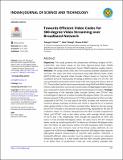| dc.description.abstract | Objectives: This study presents the compression efficiency analysis of AV1, H.265/HEVC, and VVenc based on the Peak Signal-to-Noise Ratio (PSNR) and Video Multimethod Assessment Fusion (VMAF) objective quality metrics. Methods: The study utilizes video sets from publicly available databases and YouTube. The video sets were compressed using High Efficient Video Codec (HEVC/H.265) and Versatile Video Encoder (VVenc) based on Common Test Conditions (CTC) for fixed-quality encoding at different rates. For STV-AV1, we use quantization parameters which result in the rate nearly the same as that of CTC. The encoders’ performance was evaluated using PSNR and VMAF objective metrics. Rate-distortion curves were constructed, and Bjøntegaard delta metric was computed to obtain bitrate saving/overhead between encoders. Findings: The superiority of the Versatile Video Encoder (VVenc) over STV-AV1 was unchallenged in eight out of twelve encoded 360-degree videos. The maximum bitrate saving of 72.6% and minimum of 12.8% is attained by the VVenc encoder compared to SVT-AV1. For the case of the HEVC encoder, the maximum and minimum bitrate overhead of 89.5% and 19.2% is required for it to achieve video quality similar to that of VVenc encoded video. Based on bit-rate saving, the SVT-AV1 encoder is the second most performing, especially for 6K and 5K resolution videos. It is further observed that the HEVC encoder outperforms VVenc and SVT-AV1 only in two video scenes, with average bitrate savings of 34.1% and 1.3%, respectively. Even though the popularity of HEVC still exists in most encoded 360-degree videos, the open-source STV-AV1 showed better results by outshining the HEVC in eleven out of twelve 360-degree video sets. The VVenc, an open-source version of H.266 surpasses other encoders, however, up to this moment, most of the Virtual reality platforms do not support the H.266 format. Novelty: High-resolution 360-degree video requires high-speed network infrastructure to transmit video packets. Therefore, a bandwidth-efficient video encoder must be selected to ensure an adequate immersive experience. It is well known that the HEVC encoder performance is far better than its predecessor X.264 yet, most publicly available 360-degree databases and published research works are based on video sequences encoded by using X.264 and few utilize the HEVC encoder. However, based on findings, STV-AV1 outshines HEVC with average bitrate saving of 11.6%, 34.9%, and 58% in 8K, 6K, and 4K resolution respectively making it a suitable candidate for encoding high-resolution 360-degree videos. | en_US |

